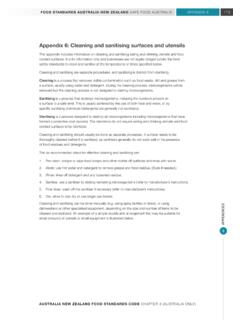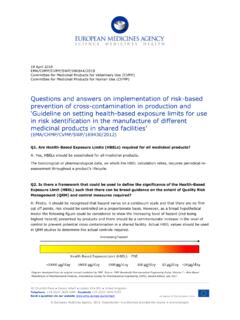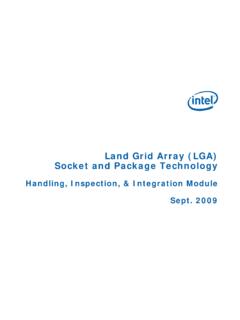Transcription of Reducing Contamination Risks of Compressed Air in Food ...
1 Parker Hannifin Corporation Filtration and Separation Division 242 Neck Road Haverhill, MA 01835 phone: 800 343 4048 or 978 858 0505 fax: 978 556 7501 Reducing Contamination Risks of Compressed Air in Food Plants: Benchmarking Good Manufacturing Practices A GMP Template for Food Plants using risk-based systems: HACCP Procedures GFSI - SQF Code Lee Scott November, 2012 Objective The objective of this technical paper is to benchmark published Good Manufacturing Practices as they relate to Compressed air use in a food processing facility in both a HACCP and/or Global Food Safety Initiative (SQF or BRC) environment.
2 Introduction Any modern food manufacturing facility employs the use of Compressed air extensively in the plant. As common as this is, the potential hazards associated with this powerful utility are not obvious and apparent. Food hygiene legislation to protect the consumer places the duty of care on the food manufacturer. For this reason, many companies often devise their own internal air quality standards based upon what they think or have been told is best practice . This is no wonder, as the published collections of Good Manufacturing Practices (GMP) that relate to Compressed air are nebulous and difficult to wade through.
3 Understandably this has led to a significant difference in the quality of Compressed air used throughout the industry, with major differences even existing in plants owned by the same company. The goal of this paper is to help make sense of it all. Focus on Preventative Food Safety: The recent focus on preventative food safety has been reinforced in the public sector in the US by the FDA s Food Safety Modernization Act (FSMA) as well as the private sector s Global Food Safety Initiative (GFSI). Both take aim at improving the knowledge of risk factors and preventative practices effectively raising the bar on food safety.
4 The combination of improvements in food science and manufacturing processes provide the GFSI and FSMA a springboard for improved food safety and awareness regarding microbial Contamination of food. Whether it is one of the many voluntary schemes (GFSI) or mandated (FSMA), there are elements to these codes that put a heavy focus on risk-based (HACCP-like) food safety management programs. The USDA has mandated risk-based programs since the late 1990 s. Risk-based food safety programs are unique to each facility and food product being manufactured and rely heavily upon the employment of GMPs and Sanitation Standard Operating Procedures (SSOPs).
5 The challenge with risk-based food safety systems is that they are not prescriptive. This works to the benefit of food manufacturers who are experts in their field of manufacturing and processes; however, it presents challenges with ancillary processes and procedures where the guidelines and GMPs are vague and non-specific. The Risk-Based HACCP Environment: When conducting a Hazard Analysis Critical Control Point (HACCP) analysis any point-of-use contact between the Compressed air and food should be considered a potential risk point. Developing an effective HACCP Prerequisite Program (PRP) for Compressed air to support Critical Control Points (CCP) is an effective way to mitigate those Risks .
6 As PRPs are generally founded upon GMPs and SSOPs this paper is intended to be an aid in deciphering best practices for Compressed air. The GFSI/SQF Environment: The number of Food manufacturing companies adopting GFSI endorsed food quality schemes is steadily growing. One of the most popular schemes in the US is the SQF Code. The 7th edition of the SQF code, released in July of 2012, now specifies in Modules 9, 10, 11, and 13 that: Compressed air used in the manufacturing process shall be clean and present no risk to food safety. Compressed air used in the manufacturing process shall be regularly monitored for purity.
7 Knowing the Potential Risks Air is not as clean as it appears to be. Untreated Compressed air contains many potentially harmful or dangerous contaminants which must be removed or reduced to acceptable levels in order to protect the consumer and provide a safe and cost effective production facility. Along with moisture and particulate matter, inlet air to a compressor generally carries 5 to 50 bacteria per ft . A 75 hp compressor with a capacity of 300 SCFM therefore takes in 100,000 to 1 million bacteria each hour13. These bacteria get Compressed along with the air and begin their journey through the Compressed air system.
8 Introducing this type of microbial Contamination to food products is very risky and would be considered a lack of control by the facility. Understanding how to operationalize the treatment of Compressed air in a facility will help ward off that risk. Where the Air Contacts the Food: Sometimes it is not apparent where the Compressed air is contacting the food. Working surfaces like counters and conveyors are obvious and manageable contact points. The air is invisible. It leaves no visible trace where it contacts the food, other food contact surfaces, or the packaging.
9 Without adequate hurdles and physical barriers in place the microbial, particulate, and (in some cases) compressor oil Contamination is left behind after the air dissipates. Some examples of direct and indirect contact points are: Bagging Sparging/Mixing Drying Air Knives Pneumatic Exhaust ( , cylinder exhaust) Managing the Risks : Compressor room drying and filtration is good, but it s not enough for a food processing plant. System filtration can do a good job Reducing the amount of contaminants that are introduced into the downstream distribution system; however, that alone does not meet the requirements of the published GMPs that address Compressed air nor is it fully effective.
10 In this scenario the risk of food adulteration is still quite high. The warm, oxygen rich environment inside the downstream air reservoirs, piping, fittings, and controls are ideal harborage sites for microbial biofilm growth especially when fed with food grade compressor oils that inevitably migrate downstream. For this reason a number of the published GMPs call for point-of-use filtration that should be in place for all points where Compressed air either directly or indirectly contacts food. The first line of defense to ward off potential microbial Contamination of the food product from Compressed air is to use point-of-use sterile air filtration.


